[English] 日本語
 Yorodumi
Yorodumi- PDB-4ftv: The complex between the high affinity version of A6 TCR (A6c134) ... -
+ Open data
Open data
- Basic information
Basic information
| Entry | Database: PDB / ID: 4ftv | ||||||
|---|---|---|---|---|---|---|---|
| Title | The complex between the high affinity version of A6 TCR (A6c134) and human Class I MHC HLA-A2 with the bound TAX nonameric peptide | ||||||
 Components Components |
| ||||||
 Keywords Keywords | IMMUNE SYSTEM / TAX peptide / nonapeptide / MHC class I / HLA-A2 / TCR A6 / cross-reactivity / high affinity / c134 | ||||||
| Function / homology |  Function and homology information Function and homology informationsymbiont-mediated perturbation of host exit from mitosis / symbiont-mediated perturbation of host cell cycle G0/G1 transition checkpoint / symbiont-mediated activation of host NF-kappaB cascade / positive regulation of memory T cell activation / T cell mediated cytotoxicity directed against tumor cell target / TAP complex binding / Golgi medial cisterna / positive regulation of CD8-positive, alpha-beta T cell activation / CD8-positive, alpha-beta T cell activation / positive regulation of CD8-positive, alpha-beta T cell proliferation ...symbiont-mediated perturbation of host exit from mitosis / symbiont-mediated perturbation of host cell cycle G0/G1 transition checkpoint / symbiont-mediated activation of host NF-kappaB cascade / positive regulation of memory T cell activation / T cell mediated cytotoxicity directed against tumor cell target / TAP complex binding / Golgi medial cisterna / positive regulation of CD8-positive, alpha-beta T cell activation / CD8-positive, alpha-beta T cell activation / positive regulation of CD8-positive, alpha-beta T cell proliferation / CD8 receptor binding / antigen processing and presentation of exogenous peptide antigen via MHC class I / beta-2-microglobulin binding / symbiont-mediated perturbation of host cell cycle G1/S transition checkpoint / endoplasmic reticulum exit site / TAP binding / antigen processing and presentation of endogenous peptide antigen via MHC class I via ER pathway, TAP-dependent / protection from natural killer cell mediated cytotoxicity / antigen processing and presentation of endogenous peptide antigen via MHC class Ib / antigen processing and presentation of endogenous peptide antigen via MHC class I via ER pathway, TAP-independent / detection of bacterium / T cell receptor binding / negative regulation of receptor binding / early endosome lumen / Nef mediated downregulation of MHC class I complex cell surface expression / DAP12 interactions / transferrin transport / cellular response to iron ion / Endosomal/Vacuolar pathway / Antigen Presentation: Folding, assembly and peptide loading of class I MHC / peptide antigen assembly with MHC class II protein complex / lumenal side of endoplasmic reticulum membrane / cellular response to iron(III) ion / negative regulation of forebrain neuron differentiation / MHC class II protein complex / antigen processing and presentation of exogenous protein antigen via MHC class Ib, TAP-dependent / ER to Golgi transport vesicle membrane / peptide antigen assembly with MHC class I protein complex / regulation of iron ion transport / regulation of erythrocyte differentiation / HFE-transferrin receptor complex / response to molecule of bacterial origin / MHC class I peptide loading complex / T cell mediated cytotoxicity / positive regulation of T cell cytokine production / antigen processing and presentation of endogenous peptide antigen via MHC class I / antigen processing and presentation of exogenous peptide antigen via MHC class II / positive regulation of immune response / MHC class I protein complex / peptide antigen binding / positive regulation of T cell activation / positive regulation of receptor-mediated endocytosis / negative regulation of neurogenesis / cellular response to nicotine / positive regulation of T cell mediated cytotoxicity / multicellular organismal-level iron ion homeostasis / SH3 domain binding / specific granule lumen / positive regulation of type II interferon production / phagocytic vesicle membrane / recycling endosome membrane / Interferon gamma signaling / Immunoregulatory interactions between a Lymphoid and a non-Lymphoid cell / negative regulation of epithelial cell proliferation / MHC class II protein complex binding / Interferon alpha/beta signaling / Modulation by Mtb of host immune system / late endosome membrane / sensory perception of smell / positive regulation of cellular senescence / tertiary granule lumen / antibacterial humoral response / DAP12 signaling / T cell differentiation in thymus / T cell receptor signaling pathway / E3 ubiquitin ligases ubiquitinate target proteins / negative regulation of neuron projection development / ER-Phagosome pathway / protein refolding / early endosome membrane / protein homotetramerization / amyloid fibril formation / intracellular iron ion homeostasis / learning or memory / host cell cytoplasm / defense response to Gram-positive bacterium / immune response / endoplasmic reticulum lumen / Amyloid fiber formation / signaling receptor binding / Golgi membrane / innate immune response / lysosomal membrane / external side of plasma membrane / focal adhesion / Neutrophil degranulation / endoplasmic reticulum membrane / positive regulation of DNA-templated transcription / host cell nucleus / SARS-CoV-2 activates/modulates innate and adaptive immune responses Similarity search - Function | ||||||
| Biological species |  Homo sapiens (human) Homo sapiens (human)Human T-cell lymphotropic virus type 1 | ||||||
| Method |  X-RAY DIFFRACTION / X-RAY DIFFRACTION /  SYNCHROTRON / SYNCHROTRON /  MOLECULAR REPLACEMENT / Resolution: 2.74 Å MOLECULAR REPLACEMENT / Resolution: 2.74 Å | ||||||
 Authors Authors | Borbulevych, O.Y. / Baker, B.M. | ||||||
 Citation Citation |  Journal: To be Published Journal: To be PublishedTitle: Structure of a high affinity TCR reveals native binding to MHC with enhanced peptide specificity Authors: Borbulevych, O.Y. / Baker, B.M. | ||||||
| History |
|
- Structure visualization
Structure visualization
| Structure viewer | Molecule:  Molmil Molmil Jmol/JSmol Jmol/JSmol |
|---|
- Downloads & links
Downloads & links
- Download
Download
| PDBx/mmCIF format |  4ftv.cif.gz 4ftv.cif.gz | 351.7 KB | Display |  PDBx/mmCIF format PDBx/mmCIF format |
|---|---|---|---|---|
| PDB format |  pdb4ftv.ent.gz pdb4ftv.ent.gz | 288.6 KB | Display |  PDB format PDB format |
| PDBx/mmJSON format |  4ftv.json.gz 4ftv.json.gz | Tree view |  PDBx/mmJSON format PDBx/mmJSON format | |
| Others |  Other downloads Other downloads |
-Validation report
| Summary document |  4ftv_validation.pdf.gz 4ftv_validation.pdf.gz | 468 KB | Display |  wwPDB validaton report wwPDB validaton report |
|---|---|---|---|---|
| Full document |  4ftv_full_validation.pdf.gz 4ftv_full_validation.pdf.gz | 475.2 KB | Display | |
| Data in XML |  4ftv_validation.xml.gz 4ftv_validation.xml.gz | 34.2 KB | Display | |
| Data in CIF |  4ftv_validation.cif.gz 4ftv_validation.cif.gz | 44.1 KB | Display | |
| Arichive directory |  https://data.pdbj.org/pub/pdb/validation_reports/ft/4ftv https://data.pdbj.org/pub/pdb/validation_reports/ft/4ftv ftp://data.pdbj.org/pub/pdb/validation_reports/ft/4ftv ftp://data.pdbj.org/pub/pdb/validation_reports/ft/4ftv | HTTPS FTP |
-Related structure data
| Similar structure data |
|---|
- Links
Links
- Assembly
Assembly
| Deposited unit | 
| ||||||||
|---|---|---|---|---|---|---|---|---|---|
| 1 |
| ||||||||
| Unit cell |
|
- Components
Components
-Protein , 4 types, 4 molecules ABDE
| #1: Protein | Mass: 31854.203 Da / Num. of mol.: 1 / Fragment: UNP residues 25-299 Source method: isolated from a genetically manipulated source Source: (gene. exp.)  Homo sapiens (human) / Gene: HLA-A, HLAA / Plasmid: pHN1 / Production host: Homo sapiens (human) / Gene: HLA-A, HLAA / Plasmid: pHN1 / Production host:  |
|---|---|
| #2: Protein | Mass: 11879.356 Da / Num. of mol.: 1 / Fragment: UNP residues 21-119 Source method: isolated from a genetically manipulated source Source: (gene. exp.)  Homo sapiens (human) / Gene: B2M, CDABP0092, HDCMA22P / Plasmid: pHN1 / Production host: Homo sapiens (human) / Gene: B2M, CDABP0092, HDCMA22P / Plasmid: pHN1 / Production host:  |
| #4: Protein | Mass: 22088.162 Da / Num. of mol.: 1 Source method: isolated from a genetically manipulated source Source: (gene. exp.)  Homo sapiens (human) / Production host: Homo sapiens (human) / Production host:  |
| #5: Protein | Mass: 27436.469 Da / Num. of mol.: 1 Source method: isolated from a genetically manipulated source Source: (gene. exp.)  Homo sapiens (human) / Production host: Homo sapiens (human) / Production host:  |
-Protein/peptide , 1 types, 1 molecules C
| #3: Protein/peptide | Mass: 1070.280 Da / Num. of mol.: 1 / Fragment: UNP residues 11-19 / Source method: obtained synthetically / Details: commercial Source: (synth.)  Human T-cell lymphotropic virus type 1 (african isolate) Human T-cell lymphotropic virus type 1 (african isolate)References: UniProt: P0C213 |
|---|
-Non-polymers , 2 types, 35 molecules 


| #6: Chemical | ChemComp-GOL / #7: Water | ChemComp-HOH / | |
|---|
-Details
| Has protein modification | Y |
|---|
-Experimental details
-Experiment
| Experiment | Method:  X-RAY DIFFRACTION / Number of used crystals: 1 X-RAY DIFFRACTION / Number of used crystals: 1 |
|---|
- Sample preparation
Sample preparation
| Crystal | Density Matthews: 2.75 Å3/Da / Density % sol: 55.21 % |
|---|---|
| Crystal grow | Temperature: 277 K / Method: vapor diffusion, sitting drop / pH: 6.5 Details: PEG3350 24%, MES 0.025M, NaCl 0.1M, pH 6.5, vapor diffusion, sitting drop, temperature 277K |
-Data collection
| Diffraction | Mean temperature: 100 K |
|---|---|
| Diffraction source | Source:  SYNCHROTRON / Site: SYNCHROTRON / Site:  APS APS  / Beamline: 19-BM / Wavelength: 0.98494 Å / Beamline: 19-BM / Wavelength: 0.98494 Å |
| Detector | Type: CUSTOM-MADE / Detector: CCD / Date: Oct 12, 2008 |
| Radiation | Monochromator: SI111 / Protocol: SINGLE WAVELENGTH / Monochromatic (M) / Laue (L): M / Scattering type: x-ray |
| Radiation wavelength | Wavelength: 0.98494 Å / Relative weight: 1 |
| Reflection | Resolution: 2.74→20 Å / Num. all: 26730 / Num. obs: 26730 / % possible obs: 100 % / Observed criterion σ(F): 1 / Observed criterion σ(I): 1 / Redundancy: 3.6 % / Rmerge(I) obs: 0.095 / Net I/σ(I): 14.9 |
| Reflection shell | Resolution: 2.74→2.9 Å / Rmerge(I) obs: 0.557 / % possible all: 99.8 |
- Processing
Processing
| Software |
| ||||||||||||||||||||||||||||||||||||||||||||||||||||||||||||||||||||||||||||||||||||||||||||||||||||||||||||||||||||||||||||||||||||||||||||||||||||||||||||||||||||||||||||||||||||||||||||||||||||||||
|---|---|---|---|---|---|---|---|---|---|---|---|---|---|---|---|---|---|---|---|---|---|---|---|---|---|---|---|---|---|---|---|---|---|---|---|---|---|---|---|---|---|---|---|---|---|---|---|---|---|---|---|---|---|---|---|---|---|---|---|---|---|---|---|---|---|---|---|---|---|---|---|---|---|---|---|---|---|---|---|---|---|---|---|---|---|---|---|---|---|---|---|---|---|---|---|---|---|---|---|---|---|---|---|---|---|---|---|---|---|---|---|---|---|---|---|---|---|---|---|---|---|---|---|---|---|---|---|---|---|---|---|---|---|---|---|---|---|---|---|---|---|---|---|---|---|---|---|---|---|---|---|---|---|---|---|---|---|---|---|---|---|---|---|---|---|---|---|---|---|---|---|---|---|---|---|---|---|---|---|---|---|---|---|---|---|---|---|---|---|---|---|---|---|---|---|---|---|---|---|---|---|
| Refinement | Method to determine structure:  MOLECULAR REPLACEMENT / Resolution: 2.74→20 Å / Cor.coef. Fo:Fc: 0.94 / Cor.coef. Fo:Fc free: 0.911 / WRfactor Rfree: 0.2546 / WRfactor Rwork: 0.208 / Occupancy max: 1 / Occupancy min: 0.5 / FOM work R set: 0.8062 / SU B: 34.589 / SU ML: 0.315 / SU Rfree: 0.3771 / Cross valid method: THROUGHOUT / σ(F): 0 / σ(I): 0 / ESU R Free: 0.377 / Stereochemistry target values: Engh & Huber / Details: U VALUES : RESIDUAL ONLY MOLECULAR REPLACEMENT / Resolution: 2.74→20 Å / Cor.coef. Fo:Fc: 0.94 / Cor.coef. Fo:Fc free: 0.911 / WRfactor Rfree: 0.2546 / WRfactor Rwork: 0.208 / Occupancy max: 1 / Occupancy min: 0.5 / FOM work R set: 0.8062 / SU B: 34.589 / SU ML: 0.315 / SU Rfree: 0.3771 / Cross valid method: THROUGHOUT / σ(F): 0 / σ(I): 0 / ESU R Free: 0.377 / Stereochemistry target values: Engh & Huber / Details: U VALUES : RESIDUAL ONLY
| ||||||||||||||||||||||||||||||||||||||||||||||||||||||||||||||||||||||||||||||||||||||||||||||||||||||||||||||||||||||||||||||||||||||||||||||||||||||||||||||||||||||||||||||||||||||||||||||||||||||||
| Solvent computation | Ion probe radii: 0.8 Å / Shrinkage radii: 0.8 Å / VDW probe radii: 1.4 Å / Solvent model: BABINET MODEL WITH MASK | ||||||||||||||||||||||||||||||||||||||||||||||||||||||||||||||||||||||||||||||||||||||||||||||||||||||||||||||||||||||||||||||||||||||||||||||||||||||||||||||||||||||||||||||||||||||||||||||||||||||||
| Displacement parameters | Biso max: 98.64 Å2 / Biso mean: 91.077 Å2 / Biso min: 9.03 Å2
| ||||||||||||||||||||||||||||||||||||||||||||||||||||||||||||||||||||||||||||||||||||||||||||||||||||||||||||||||||||||||||||||||||||||||||||||||||||||||||||||||||||||||||||||||||||||||||||||||||||||||
| Refinement step | Cycle: LAST / Resolution: 2.74→20 Å
| ||||||||||||||||||||||||||||||||||||||||||||||||||||||||||||||||||||||||||||||||||||||||||||||||||||||||||||||||||||||||||||||||||||||||||||||||||||||||||||||||||||||||||||||||||||||||||||||||||||||||
| Refine LS restraints |
| ||||||||||||||||||||||||||||||||||||||||||||||||||||||||||||||||||||||||||||||||||||||||||||||||||||||||||||||||||||||||||||||||||||||||||||||||||||||||||||||||||||||||||||||||||||||||||||||||||||||||
| LS refinement shell | Resolution: 2.74→2.81 Å / Total num. of bins used: 20
| ||||||||||||||||||||||||||||||||||||||||||||||||||||||||||||||||||||||||||||||||||||||||||||||||||||||||||||||||||||||||||||||||||||||||||||||||||||||||||||||||||||||||||||||||||||||||||||||||||||||||
| Refinement TLS params. | Method: refined / Refine-ID: X-RAY DIFFRACTION
| ||||||||||||||||||||||||||||||||||||||||||||||||||||||||||||||||||||||||||||||||||||||||||||||||||||||||||||||||||||||||||||||||||||||||||||||||||||||||||||||||||||||||||||||||||||||||||||||||||||||||
| Refinement TLS group |
|
 Movie
Movie Controller
Controller



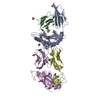
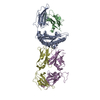
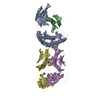
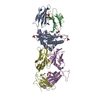
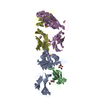
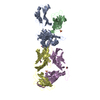
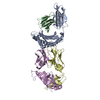
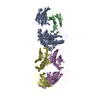
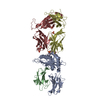

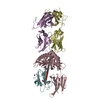
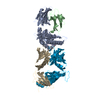
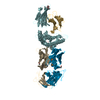

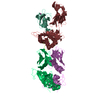
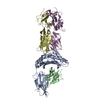
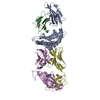


 PDBj
PDBj


